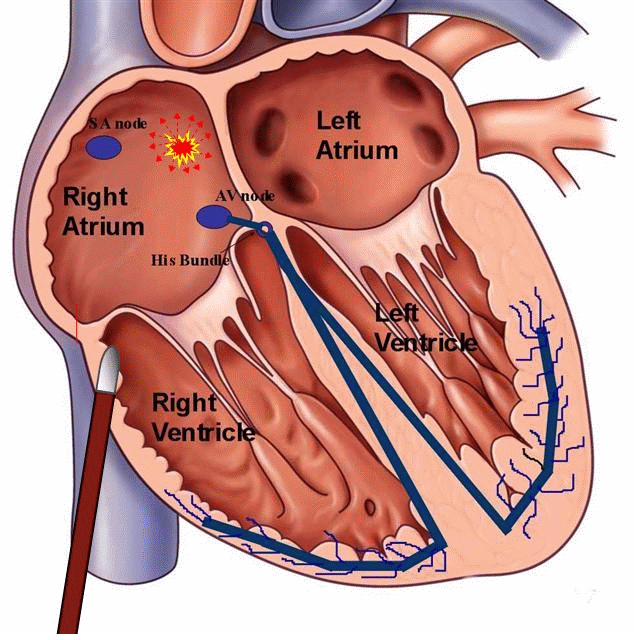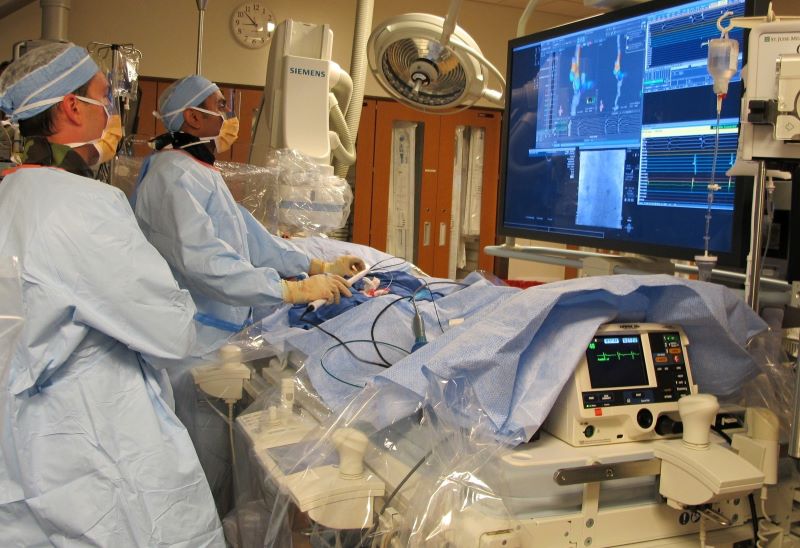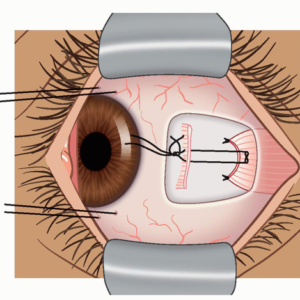Description
Familiarity with treatment
Catheter ablation is a common procedure used to treat certain types of arrhythmias, particularly those that originate in the heart’s electrical pathways. It is a minimally invasive procedure that involves the use of thin, flexible tubes called catheters.
During a catheter ablation procedure, the catheters are inserted into a blood vessel, usually in the groin, and guided to the heart. The catheters are equipped with electrodes that can deliver various forms of energy, such as radiofrequency energy or cryotherapy, to the specific areas of the heart that are causing the abnormal electrical signals.
The goal of catheter ablation is to destroy or scar the abnormal heart tissue responsible for the arrhythmia. By doing so, the procedure aims to restore a normal heart rhythm and alleviate symptoms such as palpitations, dizziness, or shortness of breath.
Catheter ablation is commonly used to treat conditions such as:
- Atrial Fibrillation (AF): This is the most common type of arrhythmia, characterized by irregular and rapid heartbeats in the atria (upper chambers of the heart). Catheter ablation can be used to isolate or destroy the abnormal electrical pathways causing AF.
- Atrial Flutter: This is a type of arrhythmia similar to AF but with a more regular pattern. Catheter ablation can be used to create scar tissue in the atria to interrupt the abnormal electrical signals.
- Supraventricular Tachycardia (SVT): This is a rapid heart rhythm originating above the ventricles (lower chambers of the heart). Catheter ablation can be used to target and eliminate the abnormal electrical pathways causing SVT.
- Ventricular Tachycardia (VT): This is a rapid heart rhythm originating in the ventricles. Catheter ablation can be used to target and destroy the abnormal tissue causing VT.
Catheter ablation is generally considered a safe and effective treatment option for certain types of arrhythmias. However, like any medical procedure, it carries some risks, such as bleeding, infection, damage to blood vessels or heart structures, or the need for repeat procedures.
Who is it suitable for?
Catheter ablation is suitable for individuals who have certain types of arrhythmias that are causing significant symptoms or affecting their quality of life. It may be considered as a treatment option when other conservative measures, such as medication, have not been effective in controlling the arrhythmia.
Specifically, catheter ablation may be suitable for individuals who have:
- Atrial Fibrillation (AF): Catheter ablation can be considered for individuals with symptomatic AF that is not well-controlled with medication or for those who experience intolerable side effects from medication.
- Atrial Flutter: Catheter ablation may be suitable for individuals with symptomatic atrial flutter that is causing significant symptoms or affecting their quality of life.
- Supraventricular Tachycardia (SVT): Catheter ablation is often recommended for individuals with recurrent episodes of SVT that are causing symptoms or affecting their daily activities.
- Ventricular Tachycardia (VT): Catheter ablation may be considered for individuals with recurrent or sustained episodes of VT, particularly if they have an underlying heart condition or have experienced life-threatening arrhythmias.
Who is it not suitable for?
While catheter ablation is a commonly performed procedure for treating certain types of arrhythmias, it may not be suitable for everyone. There are certain factors and conditions that may make an individual not suitable for catheter ablation. These can include:
- Unstable or Severe Heart Disease: Individuals with severe heart disease, such as advanced heart failure or significant blockages in the coronary arteries, may not be suitable candidates for catheter ablation. The procedure may pose additional risks or complications in these cases.
- Inaccessible or High-Risk Anatomy: In some cases, the anatomy of the heart may make it difficult or risky to perform catheter ablation. For example, if the abnormal electrical pathways are located in hard-to-reach areas or near critical structures of the heart, the procedure may not be feasible or may carry a higher risk of complications.
- Blood Clotting Disorders: Individuals with certain blood clotting disorders or those who are on blood-thinning medications that cannot be safely stopped may not be suitable for catheter ablation. The procedure carries a risk of bleeding, and the ability to safely manage and control bleeding is important.
- Pregnancy: Catheter ablation is generally not performed during pregnancy due to the potential risks to the developing fetus. It is typically postponed until after delivery.
- Limited Life Expectancy or Poor Overall Health: Individuals with a limited life expectancy or significant comorbidities that may affect their ability to tolerate the procedure or benefit from it may not be suitable candidates for catheter ablation.
Advantages
Catheter ablation offers several advantages as a treatment option for certain types of arrhythmias. Some of the key advantages include:
- Effective Treatment: Catheter ablation has been shown to be highly effective in treating certain types of arrhythmias. It can provide long-term relief from symptoms and restore a normal heart rhythm in many cases.
- Minimally Invasive: Catheter ablation is a minimally invasive procedure, meaning it does not require open-heart surgery. It is performed using small incisions and catheters inserted through blood vessels, typically in the groin area. This results in less trauma to the body, reduced pain, and faster recovery compared to traditional surgical approaches.
- Targeted Approach: Catheter ablation allows for a targeted approach to treating arrhythmias. By using specialized catheters with electrodes, the procedure can precisely target and ablate (destroy or scar) the specific areas of the heart responsible for the abnormal electrical signals. This helps to restore a normal heart rhythm while minimizing damage to healthy heart tissue.
- Personalized Treatment: Catheter ablation can be tailored to the individual’s specific arrhythmia and anatomy. The procedure can be customized based on the type, location, and severity of the arrhythmia, ensuring a personalized treatment approach for each patient.
- Reduced Medication Dependency: For individuals with arrhythmias that are not well-controlled with medication or who experience intolerable side effects from medication, catheter ablation can offer an alternative treatment option. Successful ablation can reduce or eliminate the need for long-term medication use, improving quality of life and reducing potential side effects.
- Potential for Long-Term Cure: In some cases, catheter ablation can provide a long-term cure for certain types of arrhythmias. By ablating the abnormal tissue causing the arrhythmia, the underlying problem is addressed, and the arrhythmia may not recur.
Complications
Catheter ablation is generally considered a safe and effective procedure for treating certain types of arrhythmias. However, like any medical procedure, there are potential complications that can occur. Some of the possible complications of catheter ablation include:
- Bleeding: There is a risk of bleeding at the catheter insertion site or within the heart during the procedure. Most cases of bleeding can be managed during the procedure, but in rare instances, additional interventions or blood transfusions may be required.
- Infection: Although rare, there is a small risk of infection at the catheter insertion site or within the heart. Precautions are taken to minimize this risk, such as using sterile techniques and administering antibiotics. If an infection occurs, it may require treatment with antibiotics or, in severe cases, additional procedures.
- Blood Vessel Damage: During catheter insertion or manipulation, there is a small risk of damage to the blood vessels. This can result in bleeding, hematoma (collection of blood), or blood vessel perforation. In most cases, these complications can be managed during the procedure, but in rare instances, surgical repair may be necessary.
- Heart Damage: While rare, there is a risk of damage to the heart structures during catheter ablation. This can include damage to the heart valves, coronary arteries, or the heart’s electrical system. These complications may require additional interventions or surgeries to address.
- Arrhythmia Recurrence: Despite the goal of catheter ablation to eliminate or reduce arrhythmias, there is a possibility of arrhythmia recurrence. In some cases, the ablated tissue may regenerate, or new abnormal electrical pathways may develop, leading to the return of arrhythmias. Repeat procedures may be necessary to address recurrent arrhythmias.
- Stroke or Blood Clots: During the procedure, there is a small risk of dislodging blood clots or other debris, which can potentially travel to the brain and cause a stroke or other complications. Blood-thinning medications may be used before, during, and after the procedure to minimize this risk.
- Phrenic Nerve Injury: The phrenic nerve controls the diaphragm, which is important for breathing. In rare cases, the phrenic nerve can be damaged during catheter ablation, leading to temporary or permanent diaphragm paralysis. This can cause breathing difficulties and may require further evaluation and management.
Preoperative care
Preoperative care for catheter ablation involves several important steps to ensure the safety and success of the procedure. Here are some common aspects of preoperative care:
- Medical Evaluation: Before the catheter ablation procedure, you will undergo a thorough medical evaluation. This may include a physical examination, review of your medical history, and various tests such as blood tests, electrocardiogram (ECG), echocardiogram, and possibly a stress test. These evaluations help assess your overall health and identify any potential risks or underlying conditions that may affect the procedure.
- Medication Management: Your healthcare provider will review your current medications and may make adjustments or provide specific instructions regarding their use before the procedure. Some medications, such as blood thinners, may need to be temporarily stopped or adjusted to minimize the risk of bleeding during the procedure.
- Fasting: You will typically be instructed to fast for a certain period of time before the procedure. This is to ensure that your stomach is empty, reducing the risk of complications related to anesthesia.
- Consent and Education: You will be provided with detailed information about the catheter ablation procedure, including its purpose, potential risks and benefits, and alternative treatment options. You will have the opportunity to ask questions and provide informed consent for the procedure.
- Pre-procedure Instructions: Your healthcare provider will provide specific instructions regarding any dietary restrictions, medication adjustments, or other preparations you need to make before the procedure. It is important to follow these instructions carefully to ensure the best possible outcome.
- Arrangements for Transportation and Support: Since catheter ablation is typically performed under sedation or anesthesia, you will need to arrange for someone to drive you home after the procedure. It is also helpful to have a support person accompany you to provide assistance and support during the preoperative and postoperative period.
Postoperative care
Postoperative care following a catheter ablation procedure is crucial for a successful recovery. Here are some common aspects of postoperative care:
- Monitoring: After the procedure, you will be closely monitored in a recovery area or hospital room. This includes monitoring your heart rhythm, blood pressure, and oxygen levels. The healthcare team will also assess for any signs of complications or adverse reactions to the procedure.
- Bed Rest and Recovery: You may be instructed to remain in bed or limit physical activity for a certain period of time after the procedure. This allows your body to recover and reduces the risk of bleeding or other complications. The duration of bed rest will depend on the specific details of your procedure and your healthcare provider’s recommendations.
- Pain Management: You may experience some discomfort or pain at the catheter insertion site or in the chest area. Your healthcare provider may prescribe pain medications or recommend over-the-counter pain relievers to manage any discomfort. It’s important to follow the prescribed medication regimen and report any severe or worsening pain to your healthcare provider.
- Fluid and Medication Management: Your healthcare provider will provide instructions on fluid intake and any medications you need to take after the procedure. It’s important to follow these instructions carefully to ensure proper hydration and medication management.
- Wound Care: If there are any catheter insertion sites, you will be instructed on how to care for the wounds, including keeping the area clean and dry. Your healthcare provider will provide specific instructions on wound care and when it is safe to remove any dressings or bandages.
- Follow-up Appointments: You will likely have a follow-up appointment with your healthcare provider to assess your progress and monitor your recovery. This appointment allows your healthcare provider to evaluate the success of the procedure, address any concerns or complications, and make any necessary adjustments to your treatment plan.
- Activity Restrictions: Your healthcare provider will provide specific instructions on activity restrictions and when it is safe to resume normal activities. This may include avoiding strenuous exercise, heavy lifting, or other activities that could strain the heart or disrupt the healing process.







Reviews
There are no reviews yet.